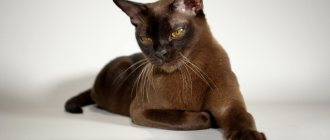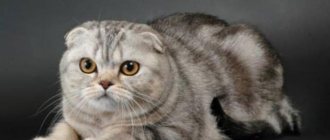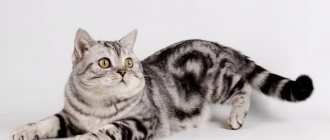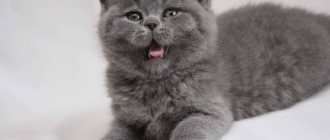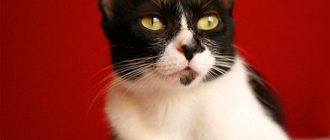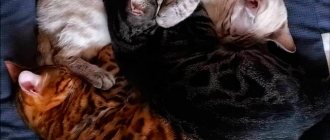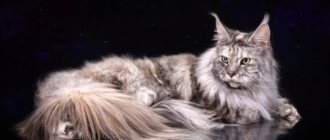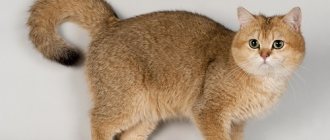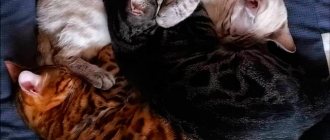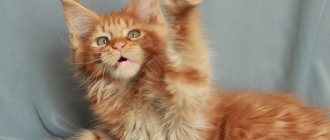What do golden chinchilla kittens look like and how to choose such a kitten.
Recently, a bright new color has appeared in the Scottish Fold breed - this is the golden ticked color. Very often this color is mistakenly called “golden chinchilla”
The golden ticked color came to our breed from British cats. Golden ticked kittens have a special charm. They look like ginger kittens, but unlike ginger kittens, they have bright green emerald eyes and a black tail tip. These kittens also have black heels and black elbows.
If you carefully examine the individual hairs of such a kitten’s fur, you will see an alternation of wide apricot stripes and thin black stripes on each individual hair.
At the same time, in general, a golden ticked kitten looks painted in one apricot color.
Only such a kitten will always have a beautiful pattern in the shape of the letter M on its forehead.
In the pedigree this color is numbered as NY 25
The golden chinchilla is the rarest of the golden colors. In such animals, the amount of black on the hair is so small that it is practically unnoticeable. On each individual hair of such a cat there will be no more than 1/12 black at the very tip of the hair. Usually black can only be seen with a magnifying glass. In the pedigree, this color is numbered as NY 12. Such kittens are born very rarely and the cost of such a kitten is usually several times higher than the cost of a golden ticked one.
Therefore, golden ticked kittens are often sold as golden chinchillas. It sounds very nice, but unfortunately, it is not entirely fair to the buyer.
However, there is another common color that is also passed off as a golden chinchilla - golden shaded.
Such an animal has a residual pattern on the body, because 1/6 of the hair is dyed black, and not 1/12, like the golden chinchilla. But in general, such a kitten will be a bright apricot color, lighter than golden ticked, but slightly darker than golden chinchilla. In the pedigree this color is numbered as NY 11.
In the nurseries of our association, kittens of all three colors described above are born.
join the discussion
Share with your friends
Scottish cats are charming pets with expressive eyes and plush fur. They are distinguished not only by their peaceful disposition, but also by their chic palette of colors. Perhaps one of the most unusual are Scottish golden cats. This shade of wool belongs to the “shaded” colors and attracts the attention of breeders around the world.
About the breed
Based on the name, this breed first appeared in Scotland. However, some researchers claim that similar cats lived in eastern countries several hundred years ago. Fluffy cats look very much like British Shorthairs.
By the way, they are considered close relatives and have many similar features.
The characteristics of the breed include the following.
- Strong muscular body of correct proportions.
- Small head with a round muzzle. Outwardly, the Scot resembles a teddy bear.
- Short well developed neck.
- Massive limbs with soft paw pads.
- Expressive eyes. In most cases, this breed has orange eyes, but there are blue-eyed and green-eyed individuals.
- The Scottish coat is soft (plush) and shiny. The fur fits tightly to the body. There are short-haired and long-haired varieties of the breed.
- Adult cats weigh no more than 6 kg. Small kittens are especially adorable and resemble a soft toy.
The main feature of the breed is the shape of the ears. The fact is that Scottish cats are divided into several types: Scottish Fold and Straight (short-haired) and Highland Fold and Straight (long-haired). Straight cats have straight ears, while animals called fold have fold ears.
Appearance
Each cat breed has characteristics specific to that species. In the case of chinchillas, experts still cannot determine the standard criteria to give accurate definitions of weight, height and other characteristics.
From a distance, the animal's fur appears to be a uniform golden tone, but this is deceiving. Each hair has a double color, at the root it is pure red, the tips are black. The color smoothly transitions into one another, which gives a slight shadedness, which is especially pronounced on the sides and on the back.
You can determine the golden color of a fur coat by the following parameters:
- the basal part of the guard hair and the undercoat are peach-colored;
- the middle part of the guard hair is black;
- upper part – shaded color;
- the tip of the hair is tipped;
- the tip of the tail is the base color.
The Scottish Golden Chinchilla has a medium-length, bouncy, plush-like coat.
Need to know. If the third part of the hair is black, the color is considered shaded, the eighth part is black - chinchilla.
Signs of a Scottish Golden Chinchilla:
- the head is round, small, with a protruding skull, pronounced chin, thick cheeks;
- forehead - with a small flat depression;
- ears – folded, tilted down and forward (Scottish fold) or straight, medium in size (Scottish Straight);
- nose – short, upturned, pale pink, with a dark outline;
- eyes – large, expressive, widely set, emerald in color, with dark edging;
- body – compact, with developed muscles, straight back, chest – raised;
- paws - the same size, rounded, with dark pads and hair between the toes;
- the tail is straight, short, thick, drooping, with a rounded tip.
The weight of an adult reaches 6-8 kg, life expectancy is 12-15 years.
Features of color
Cute and miniature pets amaze with the variety of their colors. They can be divided into the following groups.
- Plain or solid. The fur of cats is painted in one color.
- Tabby. Animal fur has a patterned color.
- Color point. White cats with blue eyes.
- Tortoiseshells. The cats' fur is "decorated" with spots of dark colors.
- Shaded . Real “jewels” among cats.
The golden color of the Scots is a unique phenomenon that attracts the attention of all avid “cat lovers”. It is classified as shaded colors. These cats have a light peach undercoat, and the fur has a beautiful golden color. The eyes are green, and the paw pads and nose are chocolate color.
Ticked cats also have a golden hue to their fur . This color is an alternation of dark and light stripes on each hair. The wool itself is cast in gold or silver. The eye color of babies is yellow, which also has a golden tint. Among the Scots, this color is rare, so ticked kittens command a high price.
TABLE: BRITISH - GOLDEN COLOR
| Black gold ticked British, photo BRI ny 25 64 | Chocolate gold ticked British, photo BRI by 25 64 | Blue golden ticked British cat, photo BRI ay 25 64 |
| Blue golden ticked British cat, photo BRI ay 25 64 | Golden ticked point British cat, photo BRI ny 25 33 | Golden ticked point color of a British cat, photo BRI fy 25 33 |
| Black golden spotted Briton, photo BRI ny 24 64 (British leopard) | Blue golden spotted British kitten, photo BRI ay 24 64 | Chocolate golden tabby British, photo BRI by 23 64 |
| Blue golden tabby British kitten, photo BRI ay 22 64 | Black golden tabby British kitten, photo BRI ny 22 64 | Chocolate golden marbled British kitten, photo BRI by 22 64 |
Care and maintenance
Before bringing a Scottish kitten home, the breeder must prepare for this event. A furry baby needs to purchase bedding made from natural materials, a small tray, a scratching post and toys in advance. Raising a kitten should be done from the first days of its arrival in the house. The Scots have a fairly easy-going disposition and are easy to “train.” They easily remember commands and respond to nicknames.
Caring for the six species, both short-haired and long-haired, requires special attention. Regular brushing and washing is the key to your pet's health. It is best to bathe the animal in warm water, at least once every 2 weeks. It is also important to keep your cats' eyes and ears clean. For the eyes, special drops purchased at a pet store are suitable. And for the hygiene of pets' ears, cotton swabs are used.
Scottish cats can be fed with natural and industrial food. For example, lean meat, cereals, fish products and boiled vegetables are perfect. As for “purchased” food, it is better for Scots breeders to choose premium products. They do not contain harmful substances and are well absorbed.
Babies are fed up to 6 times a day, and an adult cat only needs to eat 2 times a day. It is no coincidence that Scottish cats are compared to a plush toy. They are very friendly and love to play with small family members. They do not show aggression towards other animals in the house and can spend hours with their favorite toy.
See below for more information on caring for Scottish cats.
Zonal staining: what does it mean?
In kittens of ticked color, each hair of the fur is shaded with light and dark stripes of different colors - thanks to this, the fur visually seems to shimmer. Such a natural coat pattern in cats is very rare, so the science of genetics has come to the aid of breeders in this matter. To breed an animal with zonal hair coloring, a mating between representatives of such breeds as Scottish Fold cats and a British cat was needed. Since 2010, there is no need for complex crossbreeding, since breeders have enough males and females with ticked colors in different variations. Felinologists highlight the fact that in classical ticking, two genes predominate - the Abyssinian gene (Tabby) and the “general” ticking (Unpatterned). The pet's color most often combines black and gold, but it can be:
Fluffies with such fur can have marbled colors.
- brindle;
- marble;
- zonal;
- patchwork;
- spotted.
In kittens of the Scottish breed of ticked color, the pattern shades as the baby grows - this is considered the norm.
What is ticking?
Cats with fur of this color really look very attractive and unusual. The fur coat of such pets does not have the usual stripes and at the same time it does not look monochromatic.
The ticked color of cats is also called “color without color.” In this case, the stripes are not located directly on the animal’s body, but on each individual hair. A cat with such fur looks as if covered with freckles. When such an animal moves, its fur seems to shimmer and shine. Many people believe that this coloring is very similar to the colors of squirrels or chinchillas.
Health
Today, several very real versions of the origins of the British with the Golden Chinchilla color have the right to exist. Some of them report that this coloring was first recreated by British felinologist-breeders, while others indicate that American breeders and scientists participated in the development of the color isomorph.
From all these various theories about the origin of the unique color of the traditional English breed, the conclusion remains that the long-term and painstaking work of breeders has made it possible to obtain a truly luxurious shade of wool, which evokes the constant admiration of people.
What is important is that as a result of many, sometimes inbreeding, crossings, Scottish and British Golden Chinchillas have maintained excellent health and immune systems, without losing their gentle temperament.
History of the breed
Tortoiseshell Straight color The history of the straight-eared breed begins with the first fold-eared cat, whose name was Susie and she lived on a farm in Scotland.
She appeared on the farm of William Ross. He accidentally got a kitten with funny floppy ears, who was the only one in the litter among ordinary kittens. This kitten was named Snook, she was a girl. With the help of geneticists, Ross began breeding a new breed of cats. Felinologists liked her. Initially, only fold-eared individuals were bred, which were called Scottish Folds. To get the finally formed breed, scientists had to attract British cats. It was noticed that one cat brings both fold-eared and straight-eared kittens. The latter became known as Scottish Straights. After some time, the Scots stopped crossing with British cats.
Attempts were made to keep these breeds purebred, that is, Straights were supposed to remain Straights, and Folds were Folds. This experiment failed. Kittens obtained from a pair of folds were born with genetic mutations and diseases. Thus, it became clear that it was necessary to cross straight-eared cats with fold-eared ones in order to get a stable, healthy breed without problems. Straits received recognition from the WCF in 2004. They received the status of a separate independent breed. Appearance standards have also been developed, which individuals can be allowed for breeding and which cannot. The main breeding center for Straights is North America. Straight-eared cats help maintain the purity of the Scottish breed and ensure its continued existence.
Main characteristics of color
A cat's coat can only be recognized as ticked if:
- there is no extraneous pattern at all on the animal’s body - neither clear nor blurry;
- On each hair on the animal’s fur there are several dark and light stripes (at least 3 dark stripes).
The ticked color of cats, among other things, allows for stripes on the tip of the tail and paws, the presence of a “necklace” on the neck, as well as stripes in the shape of the letter “M” on the forehead. Such drawings are not considered a reason for disqualifying cats of any breed except Abyssinian.
Care and maintenance
Straights are typical homebodies who do not require walking outside. They feel great spending their entire lives in a city apartment. They are not picky about their care and do not require special living conditions. The main factors for good health and long life are proper nutrition, regular visits to the veterinarian, and hygiene procedures. The Scottish Straight kitten very quickly gets used to its litter box and only goes in it.
Hygiene rules
It is necessary to monitor the hygiene of the animal. They love cleanliness and maintain it themselves. The animal needs to be bathed periodically. Such procedures should be carried out as the coat becomes dirty, using special shampoos (no more than once every few months). Water should not get into your eyes and especially your ears. This can lead to hearing loss. Once a week, the animal needs to be combed, nails trimmed periodically, and eyes and ears cleaned. They need to be inspected every 10-14 days and, if necessary, carry out a cleaning procedure.
Bicolor color
Feeding recommendations
The diet for straight cats is no different from their lop-eared counterparts. They cannot eat fatty meat or whole milk. The diet should include turkey, chicken or veal meat, fermented milk products, vegetables, cereals, and wheat. Should be completely excluded:
- beans;
- potato;
- chocolate
- bones;
- garlic;
- spices and seasonings;
- river fish species;
- mushrooms;
- bread.
While receiving natural food, a cat may experience a deficiency of nutrients, which should be included in the diet in the form of special supplements. If you choose ready-made food, it should be premium, super-premium class. Small kittens are fed up to 6 times a day, over 6 months - five times. After a year, feeding frequency is 2-3 times a day.
Home-kept and free-range
Free range is not required for the Scottish Straight. These are absolutely pets. If you have the opportunity to take a walk in the fresh air, for example, in a country cottage or country house, you need to keep an eye on your pet. Pay special attention to protection from fleas, ticks and other parasites. Special sprays and collars are designed for this.
A free-ranging animal must have all the required vaccinations, as there is a risk of contracting infectious diseases from street cats. Some of them are deadly.
Choosing a kitten
There are quite a lot of advertisements from private owners on websites and electronic boards with offers to choose a chinchilla cat. They offer to buy a British shorthair chinchilla cat for almost pennies: from 1-2 thousand rubles. Usually for this price you get a pet without documents or pedigree.
The buyer cannot be sure of the baby’s excellent health and does not know in what conditions the kitten grew up before the sale. Unscrupulous sellers breed incompatible samples and do not monitor the breed standard. All this leads to disastrous consequences: illness and death of animals.
At a young age, it is not clear what color a cat will have. The seller will try to assure the presence of this or that breed, and on an older ward it will be difficult to see the supposed promised signs of the animal’s standard. The formation of the animal is completed by 1 year and 6 months of life.
Therefore, it is necessary to contact nurseries and clubs, experienced breeders. Advantages of a kitten purchased from a nursery:
- a metric is provided;
- you can see the baby’s parents: in the nursery or from a photograph, evaluate their appearance and behavior;
- the animal will receive all vaccinations strictly according to age;
- the pet will be treated for helminths;
- the baby is trained to the tray;
- the baby is trained in hygiene skills;
BRITISH KITTENS AND ADULT GOLDEN TABBY CATS
British golden tabby kittens can only be born from parents of this color or carriers of this color. A British golden tabby/tabby kitten should have a fairly contrasting pattern from birth. It must be remembered that over time, the color of British tabby cats “erodes” as the kitten grows, so, for example, a tabby can turn into a spotted color. The completely golden tabby color of British cats develops by the age of one year.
| In our cattery you can “buy a real British kitten.” We have many different colors, we will help you choose and answer all your questions! |
Character
British chinchilla cats are distinguished by aristocratic manners, calmness, and a good nervous system. Up to a year old, babies are very active and love to play. Adult pets are most often balanced and treat their owner as a friend. The British do not like to sit on their hands; they prefer to approach them themselves for a portion of affection.
Animals understand the situation very well and are able to manipulate the owner and family members. Plush beauties most often cannot stand strangers; there are known cases of hostility towards drunken visitors to the house. But by purchasing a British chinchilla cat, a person receives a devoted companion. The pet is attached to the house and can resort to tricks if the owner is forced to say goodbye to it. Sometimes they hide or pretend to be sick when strangers appear.
British Chinchillas get along well with other pets indoors. But the arrival of a new pet must be planned. It is necessary to separate the arriving baby from the old friend. Gradually allow animals to be together. If you do not provide for the behavior of pets, you can get sick and sick in cats.
British chinchillas are prone to depression. They buy toys and mazes for the animal. A mobile, active pet eats well and looks great.
The description of the breed and character of the British chinchilla shows: pets get along well with children. But you should not allow your child to squeeze and knead the baby immediately after coming into the house. The furry baby is given time to get used to the new home, food, smells and sounds.
Secrets of genetics
Breeders consider breeding ticked cats to be a difficult task, but at the same time very exciting. At the moment, experts have been able to identify only two genes responsible for this design of the fur of furry pets: Abyssinian and common ticking.
The first gene gives the animal's hairs ticking with the same frequency of stripes. In this case, coloring with triple zoning is considered ideal. Mandatory for such an exterior is, among other things, a stripe on the back of a slightly darker shade than the body color.
The general ticking gene does not give the number of stripes on the hairs and their distribution, but simply smoothes out the saturation in the cat’s color. The homozygous form of this U gene is capable of making the pattern on the animal’s body almost invisible. In a heterozygous one, a clear pattern is observed on the paws and tail, as well as a shadow pattern on the body. This gene has the peculiarity that it begins its work from the very birth of the kitten.
